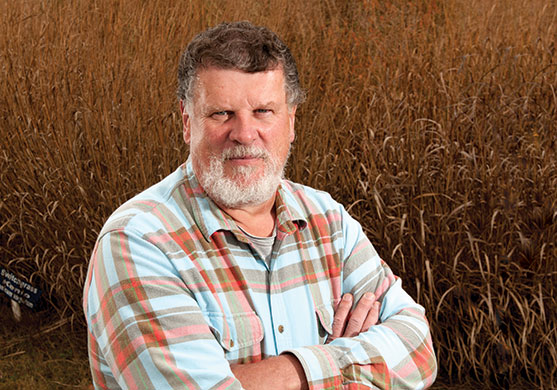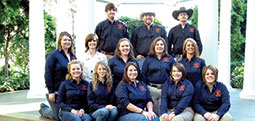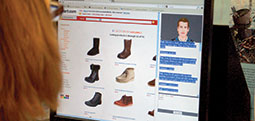| Current Issue | Past Issues | Subscribe | Ag Homepage |

Taking It All In Stride
Recovery after Loss of Foot by
“The only disability in life is a bad attitude.” —Scott Hamilton, Olympic Gold medalist
Edzard van Santen loves a good play on words—“I never turn down a great pun,” the Auburn University agronomy and soils professor says—which is why he intends to name the new switchgrass cultivar he’ll be releasing sometime in the next year ‘My Left Foot.’ Because that’s what it cost him to develop the new cultivar: his left foot.
It was a grisly 2011 farming accident at the Alabama Agricultural Experiment Station’s Upper Coastal Plain Ag Research Center that rendered van Santen physically impaired, but it very well could have rendered him dead, and that close call has done a lot to change the brusque and burly German native’s perspective on life.
“I have happily embraced ‘handicapped’ status,” says van Santen. “It certainly beats my other option.”
You could say that van Santen has taken his new standing as an amputee in stride—puns intended—and in so doing has written a remarkable comeback story in which a man admittedly “infamous for my patience,” has learned a lot about life, priorities and relationships and taught those around him volumes about determination, willpower and attitude.
The accident happened shortly after 9 a.m. Nov.10 a year ago on the outskirts of Winfield in northwest Alabama. Van Santen, a plant breeder, and the crew at the 735-acre Upper Coastal Plain research station were harvesting a quarter-acre research plot of 6-foot-tall switchgrass when van Santen, in what he describes as “a moment of inattention,” stepped in front of a razor-sharp hay-cutting blade.
The tractor-mounted cutter bar caught his leg from behind, just above the ankle, slicing through bones, muscles, nerves and two of the leg’s three major arteries. There was blood. Lots of blood. And this is the point in the story where van Santen thanks the Lord that UCP director Randall Rawls keeps his cell phone on him and that research assistant Van Dubay wears leather belts, because those two factors saved his life.
Rawls, who was driving the tractor, had just put the thing in gear when he heard a loud moan and turned to see van Santen drop to the ground. Immediately, he cut the engine, dialed 911 on his cell and sent Sandy Burleson and Cecil Parish, research technicians at the center, out to the main road to direct the ambulance to the accident scene.
Meanwhile, Dubay, a 2007 Auburn horticulture alumnus who was relatively new to his job with van Santen, was to the side of the tractor when he saw van Santen go down, was yanking off his belt to be used for a tourniquet, untangling van Santen’s foot from the blade and basically holding the victim’s foot and leg together while Upper Coastal Plain research technician Roy Akers pulled the makeshift tourniquet tight.
In what seemed to be hours but in fact was less than 10 minutes, the Marion County EMTs were on the scene, transferring van Santen from field to ambulance and on to Winfield’s Northwest Medical Center, which already had arranged for the victim to be airlifted to UAB Hospital’s level 1 trauma center.
It wasn’t until the ambulance pulled away that the reality of what had just happened began to dawn on Rawls, Dubay and the rest of the crew.
“The instant it happened, we all just sprang into reaction mode,” Rawls says. “I was real calm through it all, but once they put him in the ambulance, I pretty much fell apart.
“We all knew basic first-aid around here, and we have a first-aid kit, but no amount of training could have prepared us for that.”
“It was bad,” Dubay agrees. “What hit me the hardest was that this had happened to someone I knew.”
As soon as Rawls and Dubay gathered their wits, they headed to the Winfield hospital and were there when van Santen was wheeled out of the emergency room—where doctors had stabilized his vital signs and begun replenishing the blood he had lost—and into the waiting medical helicopter bound for Birmingham.
“And do you know what he said?” Dubay asks incredulously. “He told us to get back to the station to finish harvesting that switchgrass. Like we were in a frame of mind to do that.”
(To those who know him, that was classic van Santen—stern, brusque, no-nonsense, direct. As long-time agronomy and soils colleague David Weaver says, “Edzard tells you exactly what he thinks. There is no ‘fake’ Edzard.”)
At UAB Hospital, van Santen was wheeled straight to the trauma center’s operating room for what would be the first of five surgeries in a span of four and a half weeks. The initial operation was to thoroughly clean the wound, stop the bleeding and fixate the foot, which was still partially attached, with several pins until a future course of action was decided.
“They had a pin through my heel, one through the top of the foot and one through my shin,” van Santen recalls. “I came out of there looking like an Erector Set.”
Vicky van Santen wouldn’t have cared if he had looked like Lincoln Logs, as long as he was breathing. It had been mid-morning at Auburn’s College of Veterinary Medicine that she had been called out of a Ph.D. candidate’s dissertation defense and given a message that her husband of 33 years had been in an accident.
“I knew he and Van had left early that morning for Winfield, so I was thinking a traffic accident,” says the professor of pathobiology. “Then I was told that his foot had been cut off—which wasn’t exactly right, because it wasn’t completely severed—and finally I talked to Van, who told me he was conscious, and I was just glad to know he was alive and had no internal injuries.”
Fortunately, Christina van Santen Hierath, the eldest of the van Santens’ three children and herself a 2003 College of Ag agronomy and soils/biosystems engineering alumna, and her then-6-month-old son Carl had just arrived in Auburn from their home in Germany a couple of days before the accident, and she and the van Santens’ youngest, Katharina, a grad student at Emory University, drove their mother to Birmingham. They were there when van Santen woke up from the surgery.
“I honestly didn’t know how I would react when I finally saw him, but his positive attitude was unbelievable; it pulled me through,” Vicky van Santen says. “He was so upbeat. He knew what it was going to take to get past this. People would say, ‘Oh, you’ve done great through this,’ but I was doing great because he was doing great.”
Two days later, surgeons operated again to ensure there was no infection, and then they gave van Santen his options: They could do restorative surgery, in an attempt to save the foot, or they could amputate. The physicians clearly explained the pros and cons of both options, and to the van Santens, the cons seemed to outweigh the pros on the restoration option—it would involve four surgeries over a 12-month period, leave the left leg about 1 inch shorter than the right and carry the inherent danger of associated infections.
“We also learned that, if you have to amputate, it’s better to do it earlier than later, because you’re in better physical shape,” van Santen says.
“So I asked Vicky, ‘It comes down to this: How much do you like my left foot?’”
The amputation was performed Nov. 16, with surgeons removing van Santen’s foot up to about 4 inches above the ankle.
“It wasn’t any big production,” van Santen says. “No crying; no looking back; no sitting around trying to figure out exactly how the accident happened, no what-if this or what-if that. The damage had been done. There was only one way to go, and that was forward.”
The van Santens—all of them—were at home in Auburn for Thanksgiving 2011, not only the two daughters and grandson Carl but also son Jakob and his family, including baby Peter, who had traveled from Wisconsin.
“Having my two grandsons around was the best ‘medicine’ I could have asked for,” van Santen says. “Their smiles made my frowns disappear.”
Though exactly two weeks after the fateful day at Winfield, Thanksgiving 2011 was the merriest for the van Santens—a true celebration of life and loved ones and blessings untold. The only “negative”: Van Santen is a serious cook, baker, host and server, and for the first time ever, he had to sit on the sidelines while others took care of those duties.
“Instead of serving people, I had to be served, and I was not happy with that situation,” van Santen says. “But I was glad I was alive to be served.”
Only once, briefly, in the weeks following the accident did depression threaten to wrap its suffocating cloak around van Santen. It was the second week in December, when a trip back to Birmingham to his medical team revealed van Santen had a staph infection in the wound. He was hospitalized, put on round-the-clock intravenous antibiotics and on Dec. 12 underwent a fourth surgery in which surgeons had to shorten his leg 2 more inches to remove necrotic tissue. The van Santens were told that if in three days the infection had not cleared up, his leg would have to be amputated above the knee.
“Those were very tense, dark days—the not knowing what was going to happen,” van Santen says.
Pardon the overused phrase, but “faith, family and friends” pulled van Santen through that spell, and in follow-up surgery Dec. 15, surgeons found no sign of infection. Van Santen was on his way.
His recovery from that point on was one for the record books, thanks in large part to wife Vicky being right beside him every step of the way.
By the time he got fitted with his prosthesis in mid-January, he already had some lofty goals.
“I told the occupational therapist I wanted to be able to walk two miles by my birthday,” he says.
His birthday’s May 3; he logged his first two-mile walk the last week in March. By that time, he was also swimming close to a mile most days. He was driving even before he got his prosthesis; he reacquainted himself with his bicycle; and he never stopped working. In fact, he was on his laptop from his hospital bed in UAB less than 48 hours after the accident.
“My left foot may be gone,” he wrote in a Nov. 13, 2011, memo to College of Ag faculty and staff and his graduate students, “but my mind is not, so graduate students, there will be statistics questions during your final seminar.”
Notice there’s been no mention thus far of the pain van Santen endured at the time of the accident, through the many surgeries and throughout the recovery. That’s because there really wasn’t much to speak of, van Santen says.
“It was uncomfortable at times, yes, but I’d say that on a scale of one to 10, it never got above a five,” he says, adding that he has an uncommonly high pain threshold.
Van Santen says the events of the past 13 months have taught him at least two extremely important truths.
“I’ve learned that a lot of things aren’t nearly as important as I once thought they were,” he says. “And I learned that I married the right woman.”
December 2012
Ag Illustrated

At Your Service
Learn Business Skills
by







